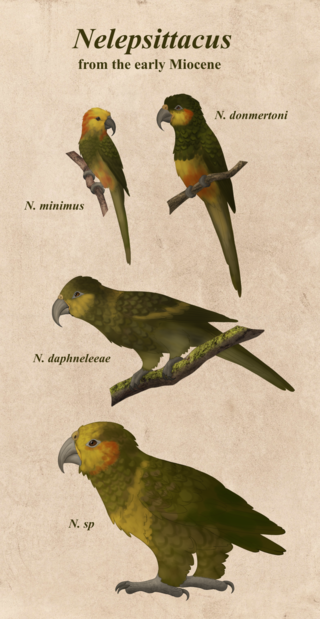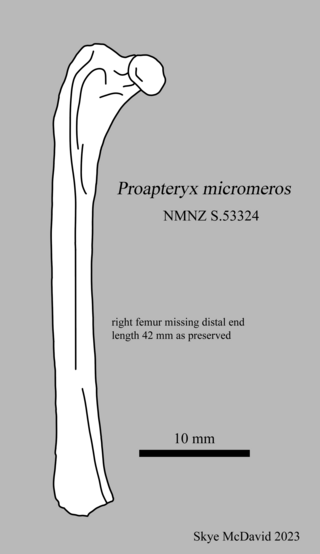
Moa are an extinct group of flightless birds formerly endemic to New Zealand. During the Late Pleistocene-Holocene, there were nine species. The two largest species, Dinornis robustus and Dinornis novaezelandiae, reached about 3.6 metres (12 ft) in height with neck outstretched, and weighed about 230 kilograms (510 lb) while the smallest, the bush moa, was around the size of a turkey. Estimates of the moa population when Polynesians settled New Zealand circa 1300 vary between 58,000 and approximately 2.5 million.

The Anatidae are the biological family of water birds that includes ducks, geese, and swans. The family has a cosmopolitan distribution, occurring on all the world's continents except Antarctica. These birds are adapted for swimming, floating on the water surface, and in some cases diving in at least shallow water. The family contains around 174 species in 43 genera.

Owlet-nightjars are small crepuscular birds related to the nightjars and frogmouths. Most are native to New Guinea, but some species extend to Australia, the Moluccas, and New Caledonia. A flightless species from New Zealand is extinct. There is a single monotypic family Aegothelidae with the genus Aegotheles.

St Bathans, formerly named Dunstan Creek, is a former gold and coal mining town in Central Otago, New Zealand. The settlement was a centre of the Otago gold rush, but mining has since long ceased. It is now largely a holiday retreat due to the preservation of many of its historic buildings.

Collocalia is a genus of swifts, containing some of the smaller species termed "swiftlets". Formerly a catch-all genus for these, a number of its former members are now normally placed in Aerodramus.
The Saint Bathans mammal is a currently unnamed extinct primitive mammal from the Early Miocene of New Zealand. A member of the Saint Bathans fauna, it is notable for being a late-surviving "archaic" mammal species, neither a placental nor a marsupial. It also provides evidence that flightless fully terrestrial mammals did in fact once live in Zealandia. This is in contrast to modern New Zealand, where bats, cetaceans and seals are the only non-introduced mammals in the otherwise bird-dominated faunas.

Nelepsittacus is a genus of extinct New Zealand parrots that is closely related to the genus Nestor. It consists of four species, of which three have been named so far. The species are all known from the early Miocene Saint Bathans Fauna from the Lower Bannockburn Formation in Otago in New Zealand.

Proapteryx micromeros is an extinct kiwi known from the 16–19 million-year-old early Miocene sediments of the St Bathans Fauna of Otago, New Zealand.
Matuku otagoense, also referred to as the Saint Bathans heron, is an extinct genus and species of heron from the Early Miocene of New Zealand. It was described from fossil material collected in 2007 from the Saint Bathans fauna of the Bannockburn Formation in Otago, South Island. It was a contemporary of the much smaller Saint Bathans bittern, remains of which have been found in the same sediments. The genus name matuku is a Māori-language word meaning “heron” or "bittern". The specific epithet is a latinisation of the name of the Otago region where the descriptive material was collected.
Rupephaps taketake, also referred to as the Saint Bathans pigeon, is an extinct species of pigeon from the Miocene of New Zealand. It is the first species of columbid to be described from pre-Pliocene fossil deposits in the Australasian region.

The St Bathans fauna is found in the lower Bannockburn Formation of the Manuherikia Group of Central Otago, in the South Island of New Zealand. It comprises a suite of fossilised prehistoric animals from the late Early Miocene (Altonian) period, with an age range of 19–16 million years ago.
Manuherikia is a genus of extinct species of ducks from the Miocene of New Zealand. It was described from fossil material of the Saint Bathans Fauna, in the lower Bannockburn Formation of the Manuherikia Group, found by the Manuherikia River in the Central Otago region of the South Island. The genus name comes from the name of the geological formation in which the fossils were found and, ultimately, from the Manuherikia River and its valley.
Dunstanetta johnstoneorum is a genus and species of extinct duck from the Miocene of New Zealand. It was described from fossil material collected from a Saint Bathans Fauna site on Home Hills Station, in the lower Bannockburn Formation of the Manuherikia Group, in the Manuherikia River valley in the Central Otago region of the South Island. The genus name refers to the Dunstan Range, the mountains of which overlook the fossil site. The specific epithet honours Ann and Euan Johnstone of Home Hills Station.
Matanas enrighti is an extinct duck from the Miocene of New Zealand. It was described from fossil material collected from a Saint Bathans Fauna site near Mata Creek, in the lower Bannockburn Formation of the Manuherikia Group, in the Manuherikia River valley in the Central Otago region of the South Island.

Pikaihao bartlei, also referred to as Bartle's bittern or the Saint Bathans bittern, is a genus and species of prehistoric small bittern from the Early Miocene of New Zealand. It was described in 2013 from fossil material found in the Saint Bathans Fauna of the Bannockburn Formation, at Home Hills Station in the Manuherikia River valley of Otago, South Island. It was a contemporary of the much larger Saint Bathans heron, remains of which have been found in the same sediments. The genus name Pikaihao comes from the Māori pi and kaihao (“fisherman”). The specific epithet honours Sandy Bartle, Curator of Birds at the Museum of New Zealand Te Papa Tongarewa from 1976 to 2009.

The Manuherikia Group is a fluvial-lacustrine sedimentary fill in the Central Otago area of New Zealand, at the site of the prehistoric Lake Manuherikia. The area consists of a valley and ridge topography, with a series of schist-greywacke mountains at roughly ninety degrees to each other. The Manuherika Group occurs in the current basins, and occasionally on the mountains themselves.
Lake Manuherikia was a prehistoric lake which once stretched over some 5,600 square kilometres (2,200 sq mi) in what is now inland Otago in New Zealand's South Island. It stretched from Bannockburn and the Nevis valley in the west to Naseby in the east, and from the Waitaki valley in the north to Ranfurly in the south, including much of the area now referred to as the Maniototo. The lake existed from around 19 to 16 million years ago during the Miocene epoch, at which point New Zealand was significantly warmer than the present.

Heracles inexpectatus is a giant fossil parrot species from New Zealand, assigned to a monotypic genus Heracles, that lived during the early Miocene approximately 16 to 19 million years ago. The species was described from two tibiotarsus fossils discovered in 2008 at Saint Bathans, Otago, New Zealand. It is believed that the species stood up to 90 cm tall and weighed approximately 7 kg (15 lb). Initial analysis suggests that this parrot is from the order Psittaciformes and from the superfamily Strigopoidea, which consists of three confirmed primitive genera of parrots: Nestor, Strigops (Kākāpō) and the fossil Nelepsittacus. It may have been the ancestor of the kākāpō.

Zealandornis is an extinct genus of zealandornithid bird from the early Miocene Bannockburn Formation of Otago, New Zealand. The genus contains a single species, Zealandornis relictus, known from a distal right humerus.
Notochen, also called the Bannockburn swan, is an extinct genus of anatid bird from the Early Miocene Bannockburn Formation of Otago, New Zealand. The genus contains a single species, Notochen bannockburnensis, known from various fossil material.













